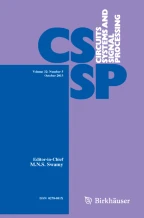Abstract
This paper derives the multi-innovation extended stochastic gradient algorithm for controlled autoregressive moving average models by expanding the scalar innovation to an innovation vector and analyzes its performance in detail. Four convergence theorems are given for the multi-innovation extended stochastic gradient algorithm to show that the parameter estimates converge to their true values under the weak persistent excitation condition. The simulation results show that the proposed algorithm can produce more accurate parameter estimates than the traditional extended stochastic gradient algorithm.
Similar content being viewed by others
References
F. Ding, T. Chen, Parameter estimation of dual-rate stochastic systems by using an output error method. IEEE Trans. Autom. Control 50(9), 1436–1441 (2005)
F. Ding, T. Chen, Performance analysis of multi-innovation gradient type identification methods. Automatica 43(1), 1–14 (2007)
F. Ding, D.Y. Xiao, T. Ding, Multi-innovation stochastic gradient identification method. Control Theory Appl. 20(6), 870–874 (2003), (in Chinese)
F. Ding, H.B. Chen, M. Li, Multi-innovation least squares identification methods based on the auxiliary model for MISO systems. Appl. Math. Comput. 187(2), 658–668 (2007)
F. Ding, Y. Shi, T. Chen, Amendments to “Performance analysis of estimation algorithms of non-stationary ARMA processes”. IEEE Trans. Signal Process. 56(10-1), 4983–4984 (2008)
F. Ding, H.Z. Yang, F. Liu, Performance analysis of stochastic gradient algorithms under weak conditions. Sci. China Ser. F Inf. Sci. 51(9), 1269–1280 (2008)
F. Ding, P.X. Liu, G. Liu, Auxiliary model based multi-innovation extended stochastic gradient parameter estimation with colored measurement noises. Signal Process. 89(10), 1883–1890 (2009)
G.C. Goodwin, K.S. Sin, Adaptive Filtering Prediction and Control (Prentice-Hall, Englewood Cliffs, 1984)
L.L. Han, F. Ding, Multi-innovation stochastic gradient algorithms for multi-input multi-output systems. Digit. Signal Process. 19(4), 545–554 (2009)
L.L. Han, F. Ding, Identification for multirate multi-input systems using the multi-innovation identification theory. Comput. Math. Appl. 57(9), 1438–1449 (2009)
L. Ljung, System Identification: Theory for the User, 2nd edn. (Prentice-Hall, Englewood Cliffs, 1999)
D.Q. Wang, F. Ding, Auxiliary models based multi-innovation generalized extended stochastic gradient algorithms. Control Decis. 23(9), 999–1003 (2008), 1010 (in Chinese)
D.Q. Wang, F. Ding, Performance analysis of the auxiliary models based multi-innovation stochastic gradient estimation algorithm for output error systems. Digit. Signal Process. 20(3), 750–762 (2010)
C.Z. Wei, Adaptive prediction by least squares prediction in stochastic regression models. Ann. Stat. 15(4), 1667–1682 (1987)
L. Yu, F. Ding, Multi-innovation stochastic gradient identification methods for CARMA systems. Sci. Technol. Eng. 8(2), 473–475 (2008), (in Chinese)
L. Yu, F. Ding, J.B. Zhang, Convergence of multi-innovation stochastic gradient identification methods. Sci. Technol. Eng. 7(21), 5474–5478 (2007), 5484 (in Chinese)
L. Yu, F. Ding, P.X. Liu, On consistency of multi-innovation extended stochastic gradient algorithms with colored noises, in Proceedings of IEEE International Instrumentation and Measurement Technology Conference, Victoria, Canada, 12–16 May 2008, pp. 1695–1700
L. Yu, Y.J. Liu, F. Ding, Convergence of multi-innovation extended stochastic gradient parameter estimation for CARMA models. Syst. Eng. Electron. 31(6), 1446–1449 (2009), (in Chinese)
J.B. Zhang, F. Ding, Y. Shi, Self-tuning control based on multi-innovation stochastic gradient parameter estimation. Syst. Control. Lett. 58(1), 69–75 (2009)
Author information
Authors and Affiliations
Corresponding author
Additional information
This work was supported in part by the National Natural Science Foundation of China (60973043), the Project Sponsored by the Scientific Research Foundation for the Returned Overseas Chinese Scholars (State Education Ministry) and the Program for Innovative Research Team of Jiangnan University.
Rights and permissions
About this article
Cite this article
Liu, Y., Yu, L. & Ding, F. Multi-innovation Extended Stochastic Gradient Algorithm and Its Performance Analysis. Circuits Syst Signal Process 29, 649–667 (2010). https://doi.org/10.1007/s00034-010-9174-8
Received:
Revised:
Published:
Issue Date:
DOI: https://doi.org/10.1007/s00034-010-9174-8
